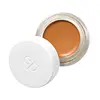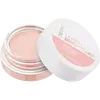What's inside
What's inside
 Key Ingredients
Key Ingredients

 Benefits
Benefits

 Concerns
Concerns

 Ingredients Side-by-side
Ingredients Side-by-side

Diisopropyl Sebacate
EmollientMica
Cosmetic ColorantEuphorbia Cerifera Cera
AstringentCopernicia Cerifera Wax
Theobroma Cacao Seed Butter
EmollientC12-15 Alkyl Benzoate
AntimicrobialHelianthus Annuus Seed Oil
EmollientArnica Montana Flower Extract
MaskingTocopherol
AntioxidantStearalkonium Hectorite
Gel FormingAscorbyl Palmitate
AntioxidantTocopheryl Acetate
AntioxidantPropylene Carbonate
SolventIron Oxides
CI 77891
Cosmetic ColorantDiisopropyl Sebacate, Mica, Euphorbia Cerifera Cera, Copernicia Cerifera Wax, Theobroma Cacao Seed Butter, C12-15 Alkyl Benzoate, Helianthus Annuus Seed Oil, Arnica Montana Flower Extract, Tocopherol, Stearalkonium Hectorite, Ascorbyl Palmitate, Tocopheryl Acetate, Propylene Carbonate, Iron Oxides, CI 77891
Pentaerythrityl Tetraisostearate
EmollientEthylhexyl Palmitate
EmollientMica
Cosmetic ColorantSorbitan Sesquioleate
EmulsifyingEuphorbia Cerifera Wax
Helianthus Annuus Seed Wax
Skin ConditioningSynthetic Fluorphlogopite
Tribehenin
EmollientDiisostearoyl Polyglyceryl-3 Dimer Dilinoleate
EmollientTapioca Starch
Butyrospermum Parkii Butter
Skin ConditioningBisabolol
MaskingTocopherol
AntioxidantHelianthus Annuus Seed Oil
EmollientRicinus Communis Seed Oil
MaskingSodium Hyaluronate
HumectantTocopheryl Acetate
AntioxidantAscorbyl Palmitate
AntioxidantHydrogenated Castor Oil
EmollientCI 77491
Cosmetic ColorantCI 77492
Cosmetic ColorantCI 77499
Cosmetic ColorantCI 77891
Cosmetic ColorantPentaerythrityl Tetraisostearate, Ethylhexyl Palmitate, Mica, Sorbitan Sesquioleate, Euphorbia Cerifera Wax, Helianthus Annuus Seed Wax, Synthetic Fluorphlogopite, Tribehenin, Diisostearoyl Polyglyceryl-3 Dimer Dilinoleate, Tapioca Starch, Butyrospermum Parkii Butter, Bisabolol, Tocopherol, Helianthus Annuus Seed Oil, Ricinus Communis Seed Oil, Sodium Hyaluronate, Tocopheryl Acetate, Ascorbyl Palmitate, Hydrogenated Castor Oil, CI 77491, CI 77492, CI 77499, CI 77891
Ingredients Explained
These ingredients are found in both products.
Ingredients higher up in an ingredient list are typically present in a larger amount.
Ascorbyl Palmitate is created by combining pure Vitamin C and palmitic acid. It is an antioxidant and helps reduce hyperpigmentation.
This ingredient is a more stable version of Vitamin C, meaning it does not disintegrate as quickly when exposed to sunlight. However, studies show it does not penetrate skin as well as pure Vitamin C.
Ascorbyl Palmitate is oil soluble.
Read more about other types of Vitamin C:
Learn more about Ascorbyl PalmitateCi 77891 is a white pigment from Titanium dioxide. It is naturally found in minerals such as rutile and ilmenite.
It's main function is to add a white color to cosmetics. It can also be mixed with other colors to create different shades.
Ci 77891 is commonly found in sunscreens due to its ability to block UV rays.
Learn more about CI 77891Helianthus Annuus Seed Oil is the oil derived from the seeds of a Sunflower. Sunflower seed oil is non-fragrant. It is an emollient, meaning it helps to soften the skin.
Sunflower seed oil contains many fatty acids. The fatty acids found in sunflower seeds include (from highest amount to least): linoleic acid, myristic acid, palmitic acid, stearic acid, arachidic acid, oleic acid, and linolenic acid.
These fatty acids help the skin create ceramides. Ceramides play a role in repairing the skin barrier.
Helianthus Annuus Seed Oil helps moisturize the skin. This in turn helps the skin look more rejuvenated and smoother.
Sunflowers are rich in vitamin E.
Historians believe Indigenous cultures of North America domesticated sunflowers before corn. Thus they relied on sunflower oil for a variety of uses. One such use is moisturizing skin and hair.
Sunflower seed oil may not be fungal acne safe. We recommend speaking with a professional if you have any concerns.
Learn more about Helianthus Annuus Seed OilMica is a naturally occurring mineral used to add shimmer and color in cosmetics. It can also help improve the texture of a product or give it an opaque, white/silver color.
Serecite is the name for very fine but ragged grains of mica.
This ingredient is often coated with metal oxides like titanium dioxide. Trace amounts of heavy metals may be found in mica, but these metals are not harmful in our personal products.
Mica has been used since prehistoric times throughout the world. Ancient Egyptian, Indian, Greek, Roman, Aztec, and Chinese civilizations have used mica.
Learn more about MicaTocopherol (also known as Vitamin E) is a common antioxidant used to help protect the skin from free-radicals and strengthen the skin barrier. It's also fat soluble - this means our skin is great at absorbing it.
Vitamin E also helps keep your natural skin lipids healthy. Your lipid skin barrier naturally consists of lipids, ceramides, and fatty acids. Vitamin E offers extra protection for your skin’s lipid barrier, keeping your skin healthy and nourished.
Another benefit is a bit of UV protection. Vitamin E helps reduce the damage caused by UVB rays. (It should not replace your sunscreen). Combining it with Vitamin C can decrease sunburned cells and hyperpigmentation after UV exposure.
You might have noticed Vitamin E + C often paired together. This is because it is great at stabilizing Vitamin C. Using the two together helps increase the effectiveness of both ingredients.
There are often claims that Vitamin E can reduce/prevent scarring, but these claims haven't been confirmed by scientific research.
Learn more about TocopherolTocopheryl Acetate is AKA Vitamin E. It is an antioxidant and protects your skin from free radicals. Free radicals damage the skin by breaking down collagen.
One study found using Tocopheryl Acetate with Vitamin C decreased the number of sunburned cells.
Tocopheryl Acetate is commonly found in both skincare and dietary supplements.
Learn more about Tocopheryl Acetate